
|

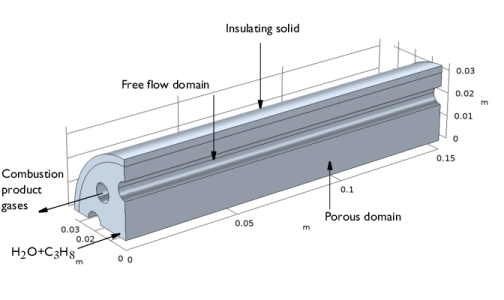
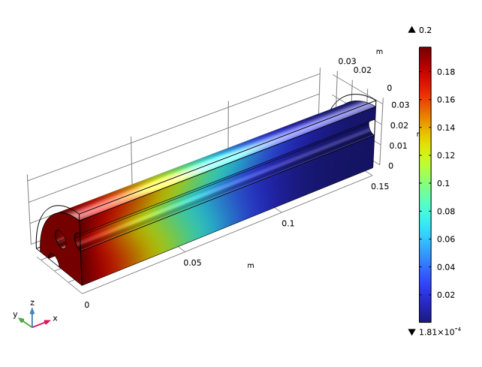
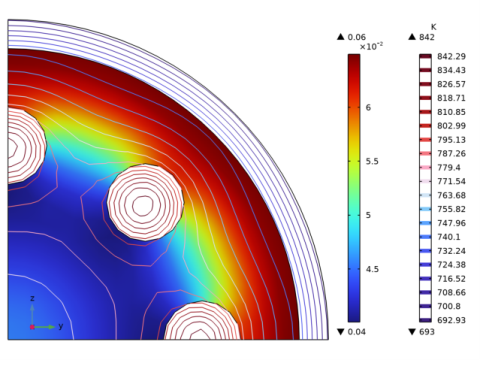

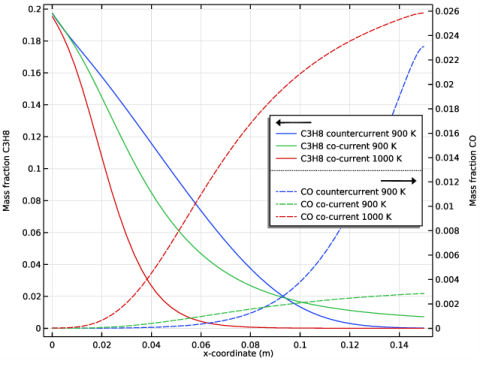
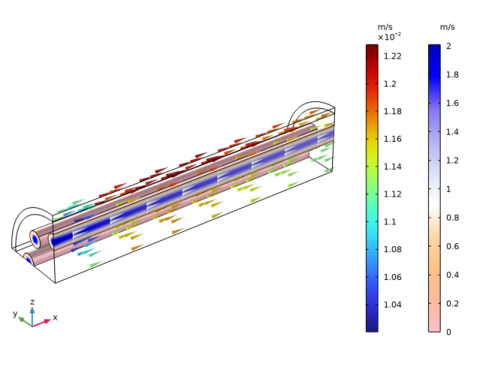
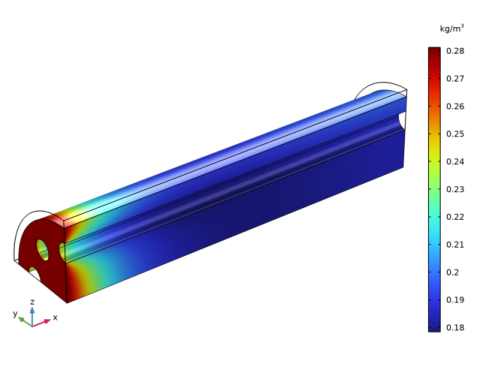
|
1
|
|
2
|
Click Next in the window toolbar.
|
|
1
|
|
2
|
|
3
|
|
4
|
|
5
|
|
6
|
|
7
|
|
8
|
|
9
|
|
10
|
|
11
|
|
12
|
Click Next in the window toolbar.
|
|
1
|
|
2
|
Click Finish in the window toolbar.
|
|
1
|
In the Model Builder window, under Global Definitions>Thermodynamics right-click Gas System 1 (pp1) and choose Generate Chemistry.
|
|
1
|
|
2
|
|
3
|
Click Next in the window toolbar.
|
|
1
|
|
2
|
|
3
|
Click Finish in the window toolbar.
|
|
1
|
|
2
|
|
3
|
|
4
|
Browse to the model’s Application Libraries folder and double-click the file steam_reformer_parameters.txt.
|
|
1
|
|
2
|
|
3
|
Browse to the model’s Application Libraries folder and double-click the file steam_reformer.mph.
|
|
4
|
|
1
|
|
2
|
|
1
|
|
2
|
|
3
|
|
4
|
|
5
|
In the Add dialog box, in the Selections to add list, choose Bed Inlet, Bed Outlet, Tubes Inlet, and Tubes Outlet.
|
|
6
|
Click OK.
|
|
1
|
|
2
|
|
3
|
|
1
|
In the Model Builder window, under Component 1 (comp1) right-click Materials and choose Blank Material.
|
|
2
|
|
1
|
|
2
|
|
3
|
|
1
|
|
2
|
|
3
|
In the tree, select Built-in>Air.
|
|
4
|
|
1
|
|
2
|
|
1
|
|
2
|
|
3
|
|
1
|
|
2
|
|
3
|
|
4
|
|
1
|
In the Settings window for Transport of Concentrated Species, locate the Transport Mechanisms section.
|
|
2
|
|
3
|
|
4
|
In the Mass fractions table, enter the following settings:
|
|
1
|
|
2
|
|
3
|
|
1
|
|
2
|
|
3
|
|
1
|
|
2
|
|
3
|
|
1
|
In the Settings window for Heat Transfer in Porous Media, click to expand the Dependent Variables section.
|
|
2
|
|
1
|
|
2
|
|
3
|
|
4
|
|
1
|
|
2
|
|
3
|
|
1
|
|
2
|
In the Settings window for Heat Transfer in Fluids, click to expand the Dependent Variables section.
|
|
3
|
|
1
|
|
2
|
|
3
|
|
4
|
|
1
|
|
2
|
|
3
|
|
4
|
|
5
|
|
6
|
|
7
|
|
8
|
|
9
|
|
10
|
|
1
|
|
2
|
|
3
|
|
4
|
Click Apply.
|
|
5
|
|
6
|
|
7
|
|
8
|
|
1
|
In the Model Builder window, under Component 1 (comp1) click Transport of Concentrated Species (tcs).
|
|
2
|
In the Settings window for Transport of Concentrated Species, type Transport of Concentrated Species in Bed in the Label text field.
|
|
3
|
|
4
|
|
1
|
In the Model Builder window, under Component 1 (comp1)>Transport of Concentrated Species in Bed (tcs) click Initial Values 1.
|
|
2
|
|
3
|
|
4
|
|
5
|
|
6
|
|
1
|
|
2
|
|
3
|
|
1
|
|
2
|
|
3
|
|
4
|
|
5
|
|
6
|
|
7
|
|
8
|
|
9
|
Locate the Diffusion section. In the table, enter the following settings:
|
|
1
|
|
2
|
|
3
|
|
1
|
|
2
|
|
3
|
|
4
|
|
5
|
|
6
|
|
7
|
|
8
|
|
1
|
|
2
|
|
1
|
In the Model Builder window, under Component 1 (comp1)>Transport of Concentrated Species in Bed (tcs) click Inflow 1.
|
|
2
|
|
3
|
|
4
|
|
5
|
|
6
|
|
7
|
|
8
|
|
1
|
|
2
|
|
3
|
|
1
|
|
2
|
|
3
|
|
1
|
In the Model Builder window, under Component 1 (comp1)>Darcy’s Law in Bed (dl)>Porous Medium 1 click Fluid 1.
|
|
2
|
|
3
|
|
4
|
|
1
|
|
2
|
|
3
|
From the list, choose Pressure.
|
|
4
|
|
5
|
|
1
|
|
2
|
|
3
|
|
4
|
|
1
|
|
2
|
|
3
|
|
1
|
|
2
|
In the Settings window for Heat Transfer in Porous Media, type Heat Transfer in Porous Media in Bed in the Label text field.
|
|
1
|
In the Model Builder window, under Component 1 (comp1)>Heat Transfer in Porous Media in Bed (ht)>Porous Medium 1 click Fluid 1.
|
|
2
|
|
3
|
|
4
|
|
5
|
|
6
|
|
7
|
|
1
|
|
2
|
|
3
|
|
1
|
In the Model Builder window, under Component 1 (comp1)>Heat Transfer in Porous Media in Bed (ht) click Initial Values 1.
|
|
2
|
|
3
|
|
1
|
|
2
|
|
3
|
|
1
|
|
2
|
|
3
|
|
4
|
|
1
|
|
2
|
|
3
|
|
1
|
|
2
|
|
3
|
|
4
|
|
5
|
|
6
|
|
1
|
|
2
|
|
3
|
|
4
|
|
5
|
|
6
|
|
1
|
|
2
|
|
3
|
|
4
|
|
1
|
|
2
|
In the Settings window for Laminar Flow, type Laminar Flow in Heating Tubes in the Label text field.
|
|
3
|
|
1
|
|
2
|
|
3
|
|
4
|
|
5
|
|
1
|
|
2
|
|
3
|
|
4
|
|
1
|
|
2
|
|
3
|
|
1
|
|
2
|
In the Settings window for Heat Transfer in Fluids, type Heat Transfer in Heating Tubes in the Label text field.
|
|
3
|
|
1
|
In the Model Builder window, under Component 1 (comp1)>Heat Transfer in Heating Tubes (ht2) click Initial Values 1.
|
|
2
|
|
3
|
|
1
|
|
2
|
|
3
|
|
4
|
|
1
|
|
2
|
|
3
|
|
1
|
|
2
|
|
3
|
|
4
|
|
5
|
|
6
|
|
1
|
|
2
|
|
4
|
|
1
|
|
2
|
|
3
|
|
4
|
|
1
|
|
2
|
|
1
|
|
2
|
|
1
|
|
2
|
|
3
|
|
1
|
|
2
|
|
3
|
Click the Custom button.
|
|
4
|
|
5
|
In the associated text field, type 2e-3/1.08.
|
|
1
|
|
2
|
|
3
|
Click the Custom button.
|
|
4
|
|
5
|
|
1
|
|
2
|
|
3
|
|
1
|
|
2
|
|
3
|
|
4
|
|
1
|
|
2
|
|
3
|
|
4
|
|
5
|
Click OK. Alternatively, click in the Graphics window to select the bed/tube boundaries.
|
|
6
|
|
7
|
|
8
|
|
9
|
|
1
|
|
2
|
|
3
|
|
4
|
|
1
|
|
2
|
|
3
|
|
1
|
|
2
|
In the Settings window for Boundary Layer Properties, locate the Geometric Entity Selection section.
|
|
3
|
|
4
|
|
5
|
|
6
|
|
7
|
|
8
|
|
1
|
|
2
|
|
3
|
|
4
|
|
5
|
|
1
|
|
2
|
In the table, clear the Solve for check boxes for Chemistry (chem), Transport of Concentrated Species in Bed (tcs), Heat Transfer in Porous Media in Bed (ht), Laminar Flow in Heating Tubes (spf), and Heat Transfer in Heating Tubes (ht2).
|
|
3
|
|
1
|
|
2
|
|
1
|
|
2
|
|
3
|
In the table, select the Solve for check boxes for Chemistry (chem), Transport of Concentrated Species in Bed (tcs), Darcy’s Law in Bed (dl), Heat Transfer in Porous Media in Bed (ht), and Heat Transfer in Heating Tubes (ht2).
|
|
4
|
|
1
|
|
2
|
|
3
|
In the Model Builder window, expand the Study 1>Solver Configurations>Solution 1 (sol1)>Stationary Solver 3 node.
|
|
4
|
Right-click Study 1>Solver Configurations>Solution 1 (sol1)>Stationary Solver 3 and choose Fully Coupled.
|
|
5
|
|
1
|
|
2
|
|
3
|
|
4
|
|
1
|
In the Model Builder window, expand the Concentration, C3H8, Surface (tcs) node, then click Surface 1.
|
|
2
|
|
3
|
|
4
|
|
5
|
|
1
|
|
2
|
In the Settings window for 3D Plot Group, type Mass fraction, C3H8, Surface (tcs) in the Label text field.
|
|
1
|
|
2
|
|
3
|
|
4
|
Click
|
|
1
|
|
2
|
|
3
|
|
4
|
|
5
|
|
6
|
|
1
|
|
2
|
|
3
|
|
1
|
|
2
|
|
3
|
|
4
|
|
5
|
|
6
|
|
7
|
|
8
|
|
9
|
|
1
|
|
2
|
In the Settings window for 1D Plot Group, type Counter current mass fractions in the Label text field.
|
|
3
|
|
1
|
|
3
|
|
4
|
|
5
|
|
6
|
|
7
|
|
8
|
Clear the Solution check box.
|
|
9
|
|
1
|
|
2
|
|
3
|
|
1
|
|
2
|
|
3
|
|
1
|
|
2
|
|
3
|
|
1
|
|
2
|
|
3
|
|
1
|
|
2
|
|
3
|
|
4
|
In the associated text field, type Mass fraction.
|
|
5
|
|
6
|
|
1
|
|
2
|
In the Settings window for Solution, type Solution 1 - Counter current T_in_tubes = 900 K in the Label text field.
|
|
1
|
In the Model Builder window, under Component 1 (comp1)>Laminar Flow in Heating Tubes (spf) click Inlet 1.
|
|
2
|
|
3
|
|
1
|
|
2
|
|
3
|
|
1
|
In the Model Builder window, under Component 1 (comp1)>Heat Transfer in Heating Tubes (ht2) click Temperature at Inlet.
|
|
2
|
|
3
|
|
1
|
|
2
|
|
3
|
|
1
|
|
2
|
In the Settings window for Solution, type Solution 1 - Cocurrent T_in_tubes = 900 K in the Label text field.
|
|
1
|
|
2
|
|
1
|
|
2
|
In the Settings window for Solution, type Solution 1 - Cocurrent T_in_tubes = 1000 K in the Label text field.
|
|
1
|
|
2
|
In the Settings window for 1D Plot Group, type w_C3H8 and w_CO along bed midline in the Label text field.
|
|
3
|
|
1
|
|
2
|
|
3
|
Locate the Data section. From the Dataset list, choose Study 1/Solution 1 - Counter current T_in_tubes = 900 K (sol4).
|
|
5
|
|
6
|
|
7
|
|
8
|
|
9
|
|
1
|
|
2
|
|
3
|
Locate the Data section. From the Dataset list, choose Study 1/Solution 1 - Cocurrent T_in_tubes = 900 K (sol5).
|
|
4
|
Locate the Legends section. In the table, enter the following settings:
|
|
1
|
|
2
|
|
3
|
Locate the Data section. From the Dataset list, choose Study 1/Solution 1 - Cocurrent T_in_tubes = 1000 K (sol6).
|
|
4
|
Locate the Legends section. In the table, enter the following settings:
|
|
5
|
|
1
|
In the Model Builder window, under Results>w_C3H8 and w_CO along bed midline, Ctrl-click to select C3H8 counter current, C3H8 co-current 900 K, and C3H8 co-current 1000 K.
|
|
2
|
Right-click and choose Duplicate.
|
|
1
|
|
2
|
|
3
|
Locate the Legends section. In the table, enter the following settings:
|
|
4
|
Click to expand the Coloring and Style section. Find the Line style subsection. From the Line list, choose Dashed.
|
|
5
|
|
1
|
|
2
|
|
3
|
|
4
|
Locate the Legends section. In the table, enter the following settings:
|
|
5
|
|
1
|
|
2
|
|
3
|
|
4
|
Locate the Coloring and Style section. Find the Line style subsection. From the Line list, choose Dashed.
|
|
5
|
Locate the Legends section. In the table, enter the following settings:
|
|
6
|
|
1
|
In the Model Builder window, under Results>w_C3H8 and w_CO along bed midline click C3H8 co-current 900 K 1.
|
|
2
|
|
1
|
In the Model Builder window, under Results>w_C3H8 and w_CO along bed midline click C3H8 counter current 1.
|
|
2
|
|
1
|
|
2
|
|
3
|
|
4
|
|
5
|
In the associated text field, type Mass fraction C3H8.
|
|
6
|
|
7
|
|
8
|
In the associated text field, type Mass fraction CO.
|
|
9
|
In the table, select the Plot on secondary y-axis check boxes for CO counter current 900 K, CO co-current 900 K, and CO co-current 1000 K.
|
|
10
|
|
11
|
|
12
|
|
13
|
|
1
|
|
2
|
In the Settings window for 1D Plot Group, type Temperature profiles along reactor in the Label text field.
|
|
1
|
In the Model Builder window, expand the Temperature profiles along reactor node, then click C3H8 counter current.
|
|
2
|
|
3
|
|
4
|
Locate the Legends section. In the table, enter the following settings:
|
|
1
|
|
2
|
|
3
|
|
4
|
Locate the Legends section. In the table, enter the following settings:
|
|
1
|
|
2
|
|
3
|
|
4
|
Locate the Legends section. In the table, enter the following settings:
|
|
1
|
In the Model Builder window, under Results>Temperature profiles along reactor click C3H8 co-current 900 K.
|
|
2
|
|
1
|
In the Model Builder window, under Results>Temperature profiles along reactor click C3H8 co-current 1000 K.
|
|
2
|
|
1
|
In the Model Builder window, under Results>Temperature profiles along reactor click CO counter current 900 K.
|
|
2
|
|
3
|
|
5
|
|
6
|
Locate the Legends section. In the table, enter the following settings:
|
|
1
|
In the Model Builder window, under Results>Temperature profiles along reactor click CO co-current 900 K.
|
|
2
|
|
3
|
|
5
|
|
6
|
Locate the Legends section. In the table, enter the following settings:
|
|
1
|
In the Model Builder window, under Results>Temperature profiles along reactor click CO co-current 1000 K.
|
|
2
|
|
3
|
|
5
|
|
6
|
Locate the Legends section. In the table, enter the following settings:
|
|
7
|
|
1
|
|
2
|
|
3
|
|
4
|
|
5
|
|
6
|
|
7
|
|
1
|
|
2
|
|
3
|
Locate the Data section. From the Dataset list, choose Study 1/Solution 1 - Counter current T_in_tubes = 900 K (sol4).
|
|
4
|
|
5
|
|
1
|
|
2
|
|
3
|
|
4
|
|
1
|
|
2
|
|
3
|
|
4
|
|
5
|
|
6
|
|
7
|
|
8
|
|
1
|
|
1
|
|
2
|
In the Settings window for Arrow Surface, click Replace Expression in the upper-right corner of the Expression section. From the menu, choose Component 1 (comp1)>Heat Transfer in Porous Media in Bed>Domain fluxes>ht.tfluxx,...,ht.tfluxz - Total heat flux.
|
|
3
|
|
4
|
|
5
|
|
6
|
|
7
|
|
8
|
|
9
|
|
10
|
|
1
|
|
2
|
In the Settings window for Arrow Surface, click Replace Expression in the upper-right corner of the Expression section. From the menu, choose Component 1 (comp1)>Heat Transfer in Heating Tubes>Domain fluxes>ht2.tfluxx,...,ht2.tfluxz - Total heat flux.
|
|
1
|
|
1
|
|
2
|
|
3
|
|
4
|
|
5
|
|
6
|
|
7
|
|
9
|
|
10
|
|
1
|
|
2
|
|
3
|
|
4
|
|
5
|
|
6
|
|
7
|
|
1
|
|
2
|
|
3
|
|
4
|
Locate the Data section. From the Dataset list, choose Study 1/Solution 1 - Cocurrent T_in_tubes = 1000 K (sol6).
|
|
5
|
|
6
|
|
1
|
|
2
|
In the Settings window for Volume, click Replace Expression in the upper-right corner of the Expression section. From the menu, choose Component 1 (comp1)>Laminar Flow in Heating Tubes>Velocity and pressure>spf.U - Velocity magnitude - m/s.
|
|
1
|
|
2
|
|
3
|
|
1
|
|
2
|
|
3
|
|
1
|
|
2
|
|
3
|
|
4
|
|
5
|
Locate the Coloring and Style section. Find the Point style subsection. From the Arrow type list, choose Cone.
|
|
6
|
|
1
|
|
2
|
In the Settings window for Arrow Surface, click Replace Expression in the upper-right corner of the Expression section. From the menu, choose Component 1 (comp1)>Laminar Flow in Heating Tubes>Velocity and pressure>u,v,w - Velocity field.
|
|
1
|
|
2
|
|
3
|
|
1
|
|
2
|
|
3
|
|
4
|
|
5
|
|
6
|
|
7
|
|
8
|
|
9
|
|
1
|
|
2
|
In the Settings window for 3D Plot Group, type Gas density reformer bed cocurrent 1000 K in the Label text field.
|
|
3
|
Locate the Data section. From the Dataset list, choose Study 1/Solution 1 - Cocurrent T_in_tubes = 1000 K (sol6).
|
|
4
|
|
5
|
|
1
|
|
2
|
|
3
|
|
4
|
|
5
|
|
1
|
|
2
|
In the Settings window for Global Evaluation, type Average temperature in bed outflow in the Label text field.
|
|
3
|
Locate the Data section. From the Dataset list, choose Study 1/Solution 1 - Cocurrent T_in_tubes = 1000 K (sol6).
|
|
4
|
Locate the Expressions section. In the table, enter the following settings:
|
|
5
|
Click
|
|
1
|
|
2
|
In the Settings window for Global Evaluation, type Average temperature in heat tube outflow in the Label text field.
|
|
3
|
Locate the Data section. From the Dataset list, choose Study 1/Solution 1 - Cocurrent T_in_tubes = 1000 K (sol6).
|
|
4
|
Locate the Expressions section. In the table, enter the following settings:
|
|
5
|
Click
|